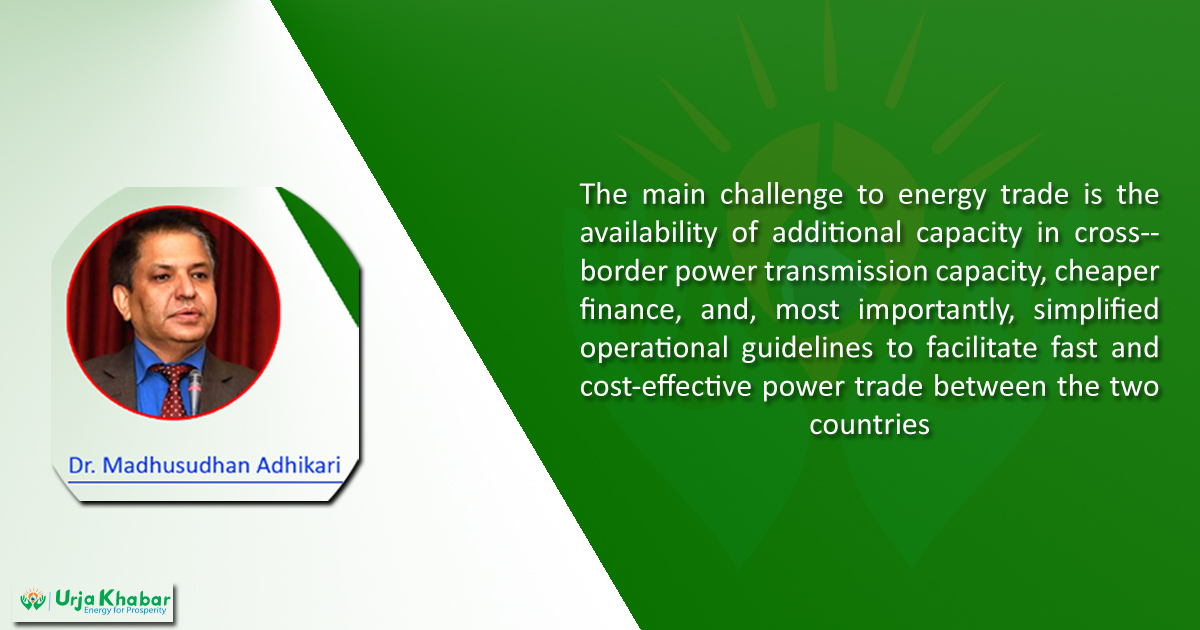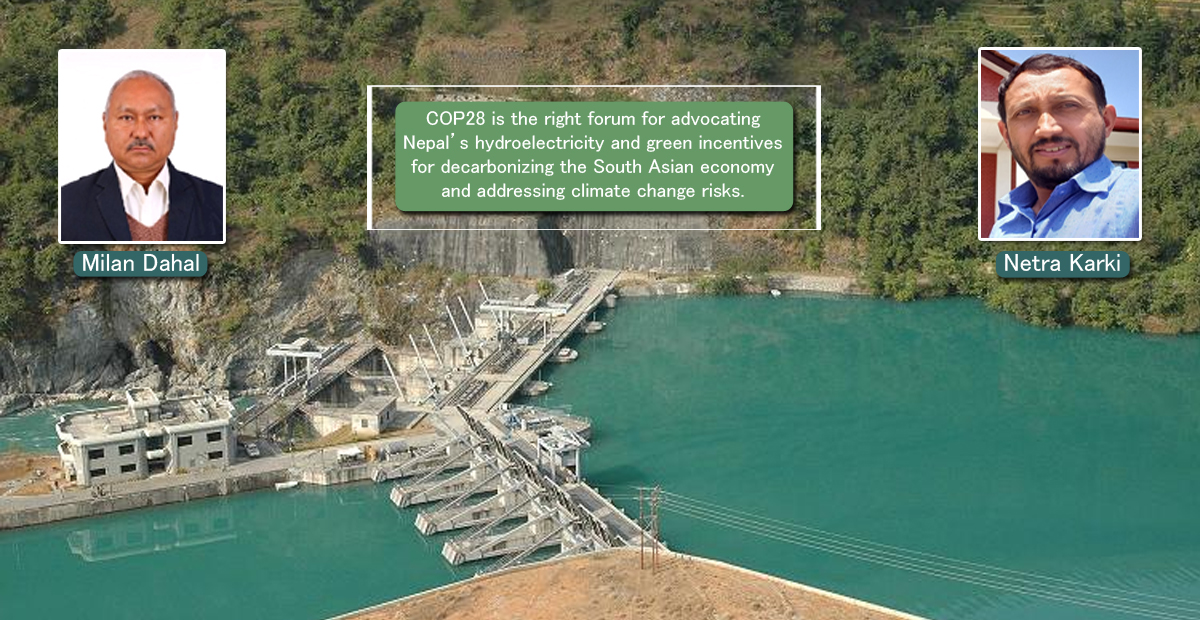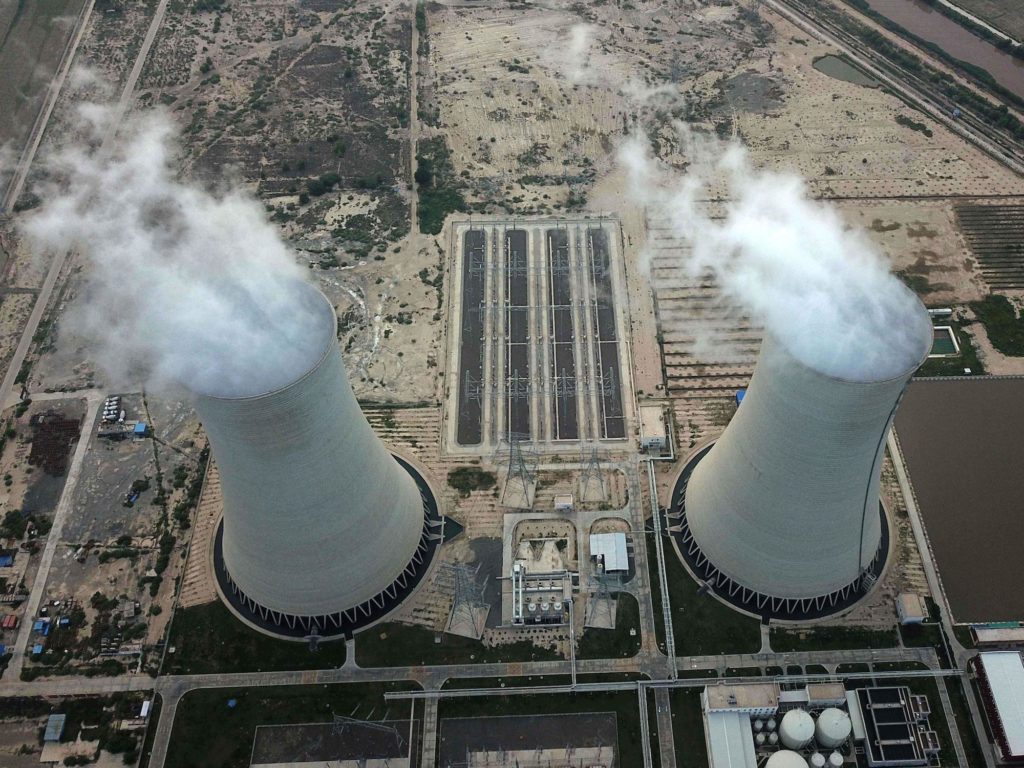Energy Update
Nepal Unlocking Cross-Border Power Trade

Nepal is blessed with extraordinary water endowments in the form of snow cover, rivers, springs, lakes, and groundwater. However, its most important water resources are the over 6,000 rivers and rivulets across the country. They not only provide a reliable source of water for different purposes but, together with the steep topography of the country, also offer significant opportunities for hydropower generation.
The technically and economically feasible hydropower potential of Nepal has been estimated at 83,000 and 42,000 megawatts (MW), respectively. Though hydropower development started in 1911, it progressed slowly until 1990, and only around 600MW was developed. After 1992, Nepal developed a Hydropower Policy and Electricity Act, which provided the opportunity to bring private sector engagement in hydropower generation. As a result, there was a steep rise in the generation curve, and as of today, the total generation capacity of the country has crossed 2800MW, providing electricity access to more than 96% of the population. In the wet season, there is more than 1000MW of surplus electricity in the country. Hence, in the wet season, Nepal has to export electricity. Recent developments along the India-Nepal border have paved the way for cross-border energy trade (CBET), offering opportunities for coordinated resource utilization and economic growth. This article explores the history, status, challenges, and opportunities in power trade between India and Nepal.

History of Power Trading Agreement
The history of the Power Trade Agreement between Nepal and India has been marked by three unsuccessful attempts. The first initiative was undertaken 25 years ago around 1997 when an important step in the Nepal-Indo Power Exchange was the Power Trade Agreement, an agreement signed with a condition to be ratified by the respective parliaments. The Power Trade Agreement signed in 1997 couldn't even be tabled in the Nepalese parliament due to domestic political issues. Compounded by the constitutional requirement for a two-thirds majority in the parliament for the ratification of agreements involving the sharing of natural resources, the Electric Power Trade Agreement was intricately linked with this constitutional provision. Despite being an exchange of ‘finished electricity,’ a product given the argument as natural resources, the agreement faced significant hurdles, and the failure to ratify it had a detrimental impact, as Nepal became a power surplus country after the commissioning of the Kali Gandaki-A Hydropower project in 2002.

The second attempt in 2010 involved Nepal presenting another draft of the Power Trade Agreement to India. Unfortunately, India did not respond for four years, rendering the second draft void. In the third attempt, initiated in 2014, India presented a new draft that leaned towards a broader cooperation agreement on the development of hydropower in Nepal and its marketing. However, Nepal was uncomfortable with such a comprehensive agreement, akin to the Indo-Bhutan cooperation model. Later, as a fourth attempt, with extra-long diplomatic and bureaucratic efforts and a revision of some of the clauses in the original draft, finally, the Power Trade Agreement signed in 2014 opened doors for Nepal to access the Indian power market, dispelling initial apprehensions about fair deals with a larger neighbor. The agreement has provisions for any party in Nepal or India (government, semi-government, or private) to agree to power trade between Nepal and India. The recent amendment in the Indian government guidelines on the Cross-Border Electricity Trade (CBET) policy further facilitates better power exchange, which eased Nepal's power trading on Indian exchanges and softened Nepal's concerns long term.
India-Nepal power trade is set to become a regional game-changer, say officials in Delhi and Kathmandu, pointing to the possibilities of buying power from Nepal and making it available over an electric grid system to consumers in India, Bangladesh, and even Sri Lanka. However, India’s reservation about buying power from projects developed by the use of Chinese contractors and equipment in the projects is still one of the serious concerns for the Nepal Electricity Authority and independent power producers (IPPs) of Nepal.
Markets for Nepal’s Power
India has allowed Nepal to sell electricity in the long term and its Real-Time Market (RMT). On July 31, the southern neighbor opened the door to Nepal, Bhutan, and Bangladesh to participate in its real-time energy market by amending the ‘Procedure for approval and facilitating import/export (cross border) of electricity by the designated authority’ issued in February 2021. It is for the first time that the southern neighbour has granted project-wise approval ensuring that Nepal could now start selling power in India’s RTM. “Nepal was the first country to participate in the RTM from South Asia,”
In May 2023, Nepali and Indian authorities signed a 5-year (medium-term) agreement that will allow Nepal to sell an additional 200 MW of hydroelectricity to India. This is in addition to the 452.6 MW that Nepal already has permission to sell in India's Real-Time Market (RTM). The new agreement applies to the wet season only (from June up until November). In June 2023, during PM Dahal's visit to India, Nepali and Indian PMs agreed to a long-term energy deal, which targets 10,000 MW of electricity import by India in 10 years. This is a significant step toward the development of the Nepal-India power trade. This landmark decision comes after several months of discussions and negotiations, and it holds immense potential for the energy sector and economic development in both nations.
Recently, on the 6th of December 2023, the Bangladesh government decided to import 40 MW of electricity from Nepal. After a long discussion at political and bureaucratic levels among the countries, India finally agreed to allow Bangladesh to initially import 40 MW of electricity from Nepal through Indian transmission infrastructure. The Baharampur-Bheramara transmission line will be used to import electricity from Nepal through the territory of India. Bangladesh will import electricity from Nepal through the Indian nodal agency NTPC Vidyut Vyar Nigam as a service provider, this has opened a new market for Nepalese clean energy.
Electricity Trade Status:
Since November 2021, the southern neighbor has been allowing Nepal to sell its power in its day-ahead market. Nepal has started exporting surplus electricity to India during the wet season, but it has to import electricity in the dry season to meet the power demand. The NEA has planned to export up to 1,200MW of electricity to India this year. The NEA is exporting 200 MW by signing the medium-term PPA and the rest to the Indian energy exchange. NEA plans to export power generated from six power projects - 83.42 MW Solukhola (Dudhkoshi) Project, 40.74 MW Mistry Khola Project, 34.92 MW Upper Balefi A Project, 28.17 MW Likhukhola-1 Project, and 12.75 MW Upper Chaku Khola Project.
According to the sources, NEA is planning to sell electricity at a rate of INR 5, which is equivalent to NRs 8 per unit. The authority has been purchasing electricity from domestic power developers at NRs 4.80 per unit. NEA has been selling electricity real-time market through the Indian energy exchange for up to INR 12 per unit. However, Nepali officials say it will be difficult to get the same rate in the case of medium and long-term PPA. In the day-ahead market of Indian Energy Exchange Limited (IEX) through daily bidding.
According to NEA, Nepal has successfully exported electricity worth NRs 11.80 billion to India during the peak production season this year. This revenue was generated over a period of more than four months, from June to October, and the selling of surplus energy is going on. The NEA has set ambitious projections, aiming to earn NRs 16 billion from the electricity business this season. Since early September, India has permitted Nepal to sell a total of 632 MW of electricity in the Indian market, reflecting a significant increase from the previous 452 MW. The approved projects for electricity export include Chilime, Solu Khola, Kabeli B-1, Likhu-4, Lower Modi, Solu-Dudhkosi, Dordi Khola, Upper Kalanga Gad, and Upper Chamelia. In the fiscal year 2021/22, Nepal's electricity exports reached 493 million units, generating an income of NRs 3.88 billion, with a notable increase to 1.34 billion units and NRs 10.45 billion in the following year.
However, Nepal is trying to push as much electricity as possible to India and aims to become a net exporter, but still, Nepal continues to spend more on buying electricity from India than earning through its exports. As Nepal’s electricity production is dominated by run-of-the-river projects, domestic production declines sharply in the dry season, requiring power import from India. Since fiscal year 2019-20, Nepal’s power import has been on a downward trend amid increasing domestic power generation in the period. According to the NEA, it spent as much as NRs 19.44 billion to buy power from India, while its export to the southern neighbor stood at NRs 10.10 billion in the last fiscal year 2022-23, suggesting the country still needs to struggle to be self-reliant in electricity. The NEA aims to be self-reliant on electricity by 2026. By the end of the current fiscal year 2022-23, Nepal’s power generation capacity is expected to reach 3000MW, 4,507 MW by mid-July 2024, and 5,251MW by mid-July 2025, according to the power utility. But domestic consumption is expected to be half the potential generation by 2025, forcing Nepal to sell electricity abroad.
India recently introduced a new rule allowing Indian distributors to incorporate imported hydropower into the renewable energy quota set for them. This may give Nepal a better chance to export more hydroelectricity to India. A new notification issued by the power ministry set a new quota of renewable energy that distribution companies should meet starting from the fiscal year 2024-25. Earlier, they were told to fulfill the quota by buying only the power produced domestically.
Challenges for Power Trade:
Transmission Infrastructure Development: To achieve the ambitious goal of exporting 10,000 MW in 10 years, there is a need for the rapid development of hydropower projects and cross-border transmission lines. The construction of new projects and transmission lines is a prerequisite, and power purchase agreements (PPAs) need to be resumed with private developers.
Building hydropower projects and transmission infrastructure is highly investment-intensive. Without a stable, long-term conducive policy and an institutional environment in place that ensures payment security, it is unlikely that investors will put their money into this risky business.
To keep the framework insulated from political volatility, a simplified legislative framework may be more desirable. The pressing need for cross-border transmission lines between Nepal and India arises from the government's ambitious goal to export a significant 10,000 MW of electricity to India in ten years.
The Nepal Electricity Authority (NEA) mentions their plan for ongoing efforts to build transmission lines of 132 kV and 400 kV capacities at multiple locations. The NEA has completed seven 132 kV transmission lines and a 400 kV Dhalkebar-Muzaffarpur line, capable of exporting 2,000 MW to India, to be the maximum available capacity for the existing infrastructure. Planned projects, including a double circuit 400 kV transmission line from Dirding to Sitamadhi and pipeline ventures like the 679 MW Lower Arun and 490 MW Arun-4, underscore the commitment to bolster transmission infrastructure to meet the growing demand for cross-border electricity trade. Initiatives like the 400 kV transmission lines from Lamki to Bareli, Duhabi-Purniya, and Butwal-Gorakhpur further underscore the comprehensive strategy in place to enhance power connectivity between the two nations. These border transmission lines must be constructed in war foot to match the increase in generation capacity.
Climate Change Challenges: India and Nepal share multiple rivers that flow from the Himalayas, each central to the lives and livelihoods of millions of citizens, and these rivers are vulnerable to the impacts of climate change and the hydropower projects built there. In particular, the Ganga River Basin (Asia’s most populous) lies mainly within India and Nepal and is beset with water-management issues, including poor river conservation, a lack of research on water resources, and insufficient groundwater recharge. Despite these factors, high-profile intergovernmental discussions between India and Nepal usually overlook climate change issues. Rather than talking about the various climate vulnerabilities of their shared rivers, India and Nepal use these meetings only to explore the potential of hydropower. This is unsurprising, given that hydro represents approximately 96% of Nepal’s installed electricity capacity, which comes from Run-of-River Power Plants: challenges during climate change impact in the wet season due to unexpected high rainfall lead to surplus generation but pose a serious threat to the safety of the hydropower structures, whereas severe drought could cause the shortfall, which will harm the smooth flow of agreed energy exchanges.
Lack of Well-Defined Framework: The approval for electricity trading between Nepal and India has been granted, but there is a lack of a well-defined framework for exporting the substantial electricity supply of 10,000 MW from Nepal to India and more to come in the future.
Policy and Structural Arrangements: Concerns are raised about the existing structural and policy arrangements, which might pose formidable challenges in achieving the export target. The specific export model and mechanism, including whether Nepal should seek an independent exporter or have a government agency oversee procurement, remain unresolved. Nepal also needs to develop policies to safeguard carbon trading rights, ensure carbon revenue belongs to Nepal, and harness maximum renewable resources for energy generation.
Guidelines and Diplomatic Relations: India's 'Guidelines for Import/Export (Cross-Border) of Electricity-2018' contain clauses linking electricity trade as a strategic issue, and open trade depends on international diplomatic relations, presenting significant hurdles. The document mentions specific clauses that might hinder electricity exports from Nepal to India.
Cybersecurity Threats: The incidences and risk of potential cyber strikes on India's electricity infrastructure in the energy exchanges also introduce a new challenge, suggesting the need for robust cybersecurity measures to safeguard against such threats and potential additional conditions for Nepal's electricity procurement.
Delay in Permissions: Private sector companies eager to engage in electricity trading face challenges in obtaining necessary permissions in both countries. The absence of a clear policy framework, despite existing provisions in the Electricity Acts, is also a major hindrance.
Coordination and Planning: In Nepal, despite the smooth growth in electricity generation, the data highlights concerns about the coordination between production, demand, and supply, posing a risk of power failures in the country which raises social concerns about export power. Comprehensive studies and planning are deemed urgent in this regard to have a clear target for national consumption and a possible amount for export as we move to the future.
Financial Requirements: Meeting ambitious targets, including generating 30,000 MW of electricity and building necessary infrastructure, requires significant financial resources, estimated to be around NRs 6 trillion. Therefore, the government of Nepal should work hard to secure soft funds from the international market and climate finance and establish legal provisions for private investors to access such funds.
Conditionality in India's Commitment: India's commitment to purchasing electricity from Nepal comes with conditions, including sourcing exclusively from projects supported by Indian or Nepali investments and not engaging in transactions with projects backed by Chinese and other investments. The government of India should not delve into the details of each project and give project-based approval for export. It is interested in energy produced from clean sources and is only concerned with the total electricity it imports, leaving all the details for the government of Nepal to monitor and regulate.
Legislative Delays: Nepal’s delay in passing the Electricity Bill, 2023, is highlighted as a factor contributing to the prolonged wait for government permissions for open access and electricity trading by private sector companies.
Operational Challenges: Despite the approval of the power purchase agreement with the ‘Take or Pay’ condition and opening for electricity trading, operational challenges, such as curtailment of production and surplus power during the wet season, are noted. This emphasizes the need for streamlined processes and unrestricted purchase of electricity by NEA from IPPs. Managing the export quota efficiently to avoid wastage during the wet season and addressing the surplus power issue is a challenge for NEA.
Dependency on Indian Market: Nepal's heavy dependency on the Indian market for electricity export raises concerns about the stability and sustainability of the export initiative, considering potential geopolitical and economic fluctuations. Even a single buyer with regulated and unpredictable pricing of electricity in the Indian market poses challenges in pricing negotiations and revenue generation for sellers.
Conclusion:
Hydropower is one of Nepal’s untapped resources. The full-fledged development of Nepal's hydro potential requires market assurance. The current level of economic development, the standard of living, and the purchasing power of the Nepalese population do not guarantee higher growth of domestic consumption. The government of Nepal is talking about the energy transition to replace traditional biomass and imported fossil fuels used in cooking and transport but lacks a definitive plan with a target to move ahead. Meanwhile, the hydropower project pipeline development by IPPs ensures that if the government of Nepal or NEA does not create hurdles in the development of identified projects, Nepal is going to get at least an annual increase of electricity production by 1500-2000 MW per year. Therefore, Nepal urgently needs to increase the export potential for its surplus electricity in the days to come.
The main challenge to energy trade is the availability of additional capacity in cross-border power transmission capacity, cheaper finance, and, most importantly, simplified operational guidelines to facilitate fast and cost-effective power trade between the two countries. Electricity trading between Nepal and India has significantly benefited the socio-economic development of both countries. Nepal can gain by developing its major resource, hydropower potential, for which it will have a market, and export earnings can boost its economy and human well-being.
India, on the other hand, can promote renewable energy sources like solar and wind power, whose intermittency can be balanced by importing from Nepal’s flexible hydropower. Electricity import reduces the generation of coal and gas, thereby reducing the emission of greenhouse gases. Nepal's journey toward a sustainable energy future faces challenges, but a comprehensive approach involving policy reforms, strategic collaborations, and diplomatic efforts with neighboring countries, especially India, can unlock the country's vast potential in clean energy generation. This not only achieves the net-zero emission goal for Nepal but also helps neighboring countries reach their targets as planned.
Dr. Adhikari, Senior Energy Expert, this article is taken from 5th issue of Urja Khabar Semi-annual Journal Publish on 17th December, 2023
Conversation
- Info. Dept. Reg. No. : 254/073/74
- Telephone : +977-1-5321303
- Email : [email protected]














